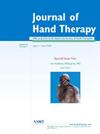Prioritize proximal interphalangeal joint extension, a cadaver study clarifying PIPJ neutral position and joint capsular behavior
IF 1.8
4区 医学
Q2 ORTHOPEDICS
引用次数: 0
Abstract
Background
Dysmobility of the proximal interphalangeal joint (PIPJ) often arises following trauma, inflammation, or surgery, leading to joint stiffness and reduced range of motion. This condition results from capsular shortening and the development of arthrofibrosis, which restricts mobility and contributes to contracture formation.
Purpose
This study investigates the influence of joint position on capsular space volume distribution in the PIPJ, hypothesizing that the mid-flexion position maximizes capsular space, contributing to ligament shortening and arthrofibrosis. This study investigates the influence of joint position on capsular space volumen distribution in PIPJ, hypothesizing that the mid- flexion position maximizes capsular space, contributing to ligament shortening and arthrofibrosis.
Study Design
A cadaveric study examining capsuloligamentous dynamics of the PIPJ across various joint positions.
Methods
Fifteen fingers from five fresh frozen cadaver specimens were evaluated through three studies:
- 1.Assessment of capsular dynamics during flexion extension.
- 2.High-pressure silicone injection into the PIPJ to determine the resulting joint position and capsular space volume.
- 3.High-pressure latex injection in extension, neutral, and flexion positions to measure capsular space volume and fluid distribution.
Results
1. The PIPJ demonstrated close-packed positions at full flexion and extension, with maximum capsular space volume observed in the mid-flexion position (30°-40° flexion).
2. Silicone injection consistently held the joint in a mid-flexion position, indicating maximal capsular volume.
3. Latex distribution varied with joint position, concentrating dorsally in extension, spreading equally volar-dorsal in mid-flexion and shifting volarly in flexion.
Conclusions
We propose call to call the mid-flexion position (of 30º-40º flexion) the “neutral” position. This position maximizes capsular space volume, facilitating ligament shortening and arthrofibrosis. Extension minimizes volar capsularspace volume and may be essential for preventing flexion contractures. Clinically, immobilizing the proximal interphalangeal joint in extension with dorsal compression may help prevent contracture and reduce edema, while manual therapy should target the mid-flexion position to enhance joint mobilization.
优先考虑近端指间关节伸展,一项澄清PIPJ中立位置和关节囊行为的尸体研究。
背景:近端指间关节(PIPJ)活动障碍常在创伤、炎症或手术后出现,导致关节僵硬和活动范围缩小。这种情况是由于关节囊缩短和关节纤维化的发展,这限制了活动并导致挛缩的形成。目的:本研究探讨关节位置对PIPJ关节囊空间体积分布的影响,假设中屈曲位置使关节囊空间最大化,导致韧带缩短和关节纤维化。本研究探讨了关节位置对PIPJ关节囊空间体积分布的影响,假设中屈曲位置使关节囊空间最大化,导致韧带缩短和关节纤维化。研究设计:一项尸体研究,检查PIPJ在不同关节位置上的囊膜脱落动力学。方法:对5例新鲜冷冻尸体标本的15根手指进行3项研究。PIPJ在完全屈曲和伸展时位置紧密,在中屈曲位置(30°-40°屈曲)观察到最大的囊腔空间体积。2. 硅胶注射始终保持关节在中屈位置,表明最大的荚膜体积。3. 乳胶分布随关节位置的变化而变化,伸展时集中于背侧,中屈曲时均匀分布于掌侧-背侧,屈曲时掌侧移位。结论:我们建议将中屈曲位(30º-40º屈曲)称为“中性”位。该体位使囊腔容积最大化,促进韧带缩短和关节纤维化。伸展使掌侧囊腔体积最小化,可能是防止屈曲挛缩所必需的。临床上,将近端指间关节固定在伸展状态并进行背侧压迫有助于预防挛缩和减少水肿,而手工治疗应针对中屈曲位,以增强关节活动。
本文章由计算机程序翻译,如有差异,请以英文原文为准。
求助全文
约1分钟内获得全文
求助全文
来源期刊

Journal of Hand Therapy
医学-外科
CiteScore
3.50
自引率
10.00%
发文量
65
审稿时长
19.2 weeks
期刊介绍:
The Journal of Hand Therapy is designed for hand therapists, occupational and physical therapists, and other hand specialists involved in the rehabilitation of disabling hand problems. The Journal functions as a source of education and information by publishing scientific and clinical articles. Regular features include original reports, clinical reviews, case studies, editorials, and book reviews.
 求助内容:
求助内容: 应助结果提醒方式:
应助结果提醒方式:


